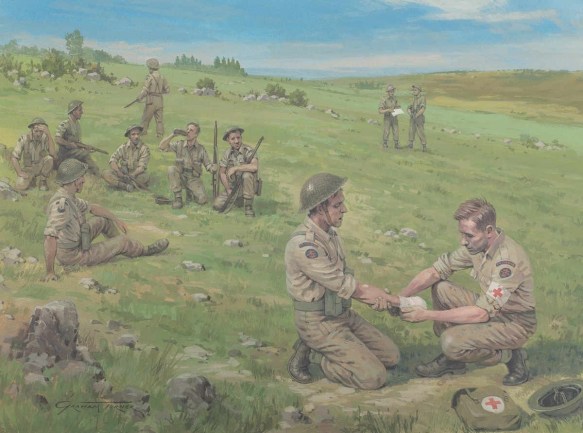
The British and American armies under Generals Montgomery and Patton were to land on Sicily two months after the Axis capitulation in North Africa, where a quarter of a million soldiers surrendered, some 125,000 of these German. Coming as it did on the heels of the disaster at Stalingrad, the loss of yet another whole army came as a second terrible blow to Hitler.
There were only two German divisions on Sicily, one of them the tough Hermann Goering Panzer grenadier, the other six were Italian, most assigned the role of coastal defence and ripe for surrender before the invasion fleet came over the horizon. The two-pronged Allied assault would take on the nature of a race between the rivals, Patton and Monty. Many small encounters would never be recorded, save perhaps in abbreviated form in unit histories. One such occurred when two small parties comprising British commandos and pioneers were landed on a remote part of the island coast in order to reconnoitre any Italian resisters. Little opposition was expected in this pre-dawn landing as the soldiers scrambled ashore well ahead of the main armies then about to begin disembarking from their transports offshore. Although these were accompanied by warships, there was no pre-landing bombardment. The invasion morning produced something like an anti-climax, especially for the tough commandos who in their young zeal were fired up for action.
Obviously, the Germans had concentrated their own force inland, leaving their supposed allies to resist on the coast, though having little faith in the Italian soldiers putting up much of a fight. As the commandos climbed the bare slopes, weapons at the ready, the troopships at sea began disembarking their loads. The commandos’ enthusiasm soon evaporated as they encountered not a soul, and as they reached the clifftop, sweating and tiring from the climb, their officers commiserated with each other on the disappointment they shared. No commando had fired a shot, no pioneer had seen a chance to blow up any enemy forts and bunkers.
The two squads then pushed on along the clifftop ridge, until in a sudden dip they encountered an enemy pillbox. Uncamouflaged, its dirty-looking concrete sat among the sandy soil and scrub grass, with a steel door visible at the rear, its weapon slits placed for all-round defence. The two British parties had dropped to the ground to survey this menace, both officers peering through binoculars, trying to decide if the post was manned. No weapons poked through the embrasures. Finally, the commando lieutenant remarked, `It’s OK, old chap, we can deal with this.’
`Oh?’ the pioneer officer responded. `It’s one for us, I believe.’
So they tossed a coin. The pioneer won and brought his men forward with their explosives to set charges around the structure as the commando officer withdrew in disgust with his own troops.
Suddenly, all the British soldiers were startled to see a solitary figure in green uniform appear beside the pillbox. It was one of the Italian defenders. He peered at the invaders briefly before vanishing through the steel door again. Not a moment later a white rag tied to a stick was poked out of the doorway. The British watched with mixed feelings as several Italians, minus equipment, stepped tentatively outside. The two British lieutenants grinned and cursed mildly.
The commando officer sat down to open up his ration pack and his men started to brew some tea while their engineer comrades got on with the job. The commando officer, grinning, now suggested `tickling up’ the Italians with a Bren. His opposite number obliged, picking up their light machine-gun to send a burst of fire over the heads of the startled Italians, who rushed back into their bunker. A moment later they fired a few token shots from their embrasures, this act finally sealing their fate.
That settles it,’ the pioneer officer remarked, and he ushered his men off with their explosive charges. The pillbox door had been left ajar so that the white flag could continue to be waved in surrender. A few more rounds changed that. The door was slammed shut and the pioneers got on with their task, laying charges at intervals round the bunker and withdrawing hurriedly.
The engineer officer had never been in any doubt as to his proper course of action: every enemy fortification found had to be destroyed, with or without the enemy within. He now stood erect, contemptuous of any possible Italian fire, announcing that the commandos would now see a demonstration in the art of demolition. The wretched Italians, meanwhile, unaware perhaps that their last moments were at hand, were jabbering together inside what was about to prove their steel and concrete coffin.
And so it proved. The enemy soldiers’ arguments among themselves on the best course of action were cut short very abruptly as the charges were detonated and the whole structure, complete with occupants, was reduced to rubble in an explosion that proved most satisfying for the onlookers, who then proceeded to enjoy breakfast as they admired their handiwork and watched the troop-laden craft approaching the beaches